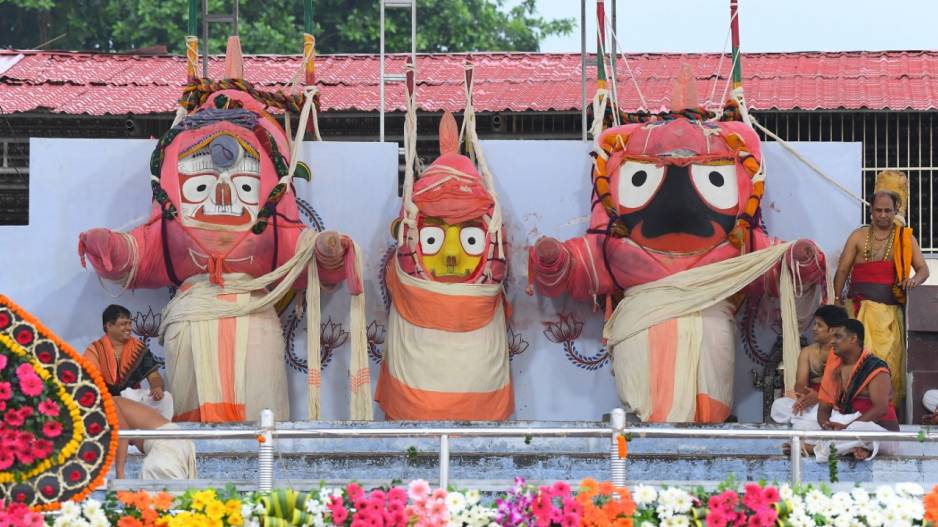World famous Rath Yatra is one of the biggest festivals not just in Odisha but in several parts of the country. However, at the apex of this sacred event stands Debasnana Purnima or simply Snana Purnima where the deities are given sacred bath followed by magnificent Hati Besha. Hati Besha, also known as Gajanana Besha or adorning of the deities with elephant attire, signifies a sacred tradition where Lord Jagannath, accompanied by his divine siblings, Lord Balabhadra and Goddess Subhadra, takes on the majestic appearance of elephants. But have you wondered what might be the story behind the majestic attire of the holy trinity. Ahead of Snana Purnima, Sunday POST sheds light on the rituals and the legend behind it.
The ritual
Lord Jagannath takes up Gajanana Besha on the full moon day in the month of Jyestha, known as Snana Purnima. On this auspicious day, the deities are ceremonially brought in a procession to the Snana Bedi, the bathing platform located in Ananda Bazar. The bathing ritual involves the use of scented water, meticulously prepared since the previous night by devoted servitors. After the deities receive the ceremonial bath on the platform, servitors proceed to the mutts to procure materials for the idols’ adornment. These materials, essential for the besha, are acquired from Gopal Tirtha Mutt and Raghab Das Mutt. Once the besha is completed by the servitors, offerings are made to the deities, allowing devotees the opportunity to witness their divine presence and seek their blessings.
Lord Jagannath and Ganapati Bhatta
Hailing from the village of Kaniari in present-day Karnataka, Ganapati Bhatta was a spiritual seeker devoted to the Ganapatya sampradaya, which worships Lord Ganesha as the supreme deity. Intrigued by the writings in Brahma Purana about Lord Jagannath, he embarked on a pilgrimage to Shrikshetra Puri, with the hope of experiencing the divine grace of Jagannath. He arrived at the temple and went to participate in the ceremonious bathing ritual of the Lord. However, upon catching a glimpse of Lord Jagannath, Ganapati Bhatta’s heart sank. The deity before him lacked the elephant head that he associated with his beloved Ganesha. Disappointment clouded his spirit, and he left the premises. His devotion was solely reserved for Lord Ganesha, and he longed to worship him alone. Realising his devotees’ dissatisfaction, Lord Jagannath set in motion a divine plan to address Bhatta’s devotion and provide solace to him.
The incarnation
Lord Jagannath, in the guise of a learned Brahmin, met Bhatta who was about to leave Puri. He wouldn’t have to leave Srikhetra disheartened, Bhatta was told. The Brahmin also reassured him that he should visit the temple once again if he wants to have a darshan of his Lord. Charmed by the soft-spoken Brahmin, Bhatta eventually agreed to revisit the temple in the evening. Little did he know that the Jagannath had orchestrated a wondrous surprise, destined to unfold within the hallowed grounds of the temple. Filled with a renewed sense of anticipation, he made his way to the temple, guided by the promise bestowed upon him by the enigmatic Brahmin.
Surprise of life
Bhatta’s joy knew no bounds as he witnessed Lord Jagannath’s Hati Besha, resembling his beloved Lord Ganesha. Jagannath had assumed this form to please his beloved devotee, and a radiant smile adorned his divine face. Overwhelmed, Bhatta repeatedly bowed to him with his heart brimming with indescribable joy and gratitude.
‘The ultimate truth’
Bhatta understood that Lord Jagannath was the Supreme Lord Himself. He saw that everything in the world came from this holy source. Once thought of as separate beings, the demigods were now shown to be part of the Supreme Lord, with their powers coming only from His vast essence and Bhatta realised the ultimate truth. With his newfound clarity, he saw how all beings are related to each other and to the Supreme Lord. He also realised that every part of existence comes from the Supreme Lord’s eternal source.
Divine bath and recovery
Following the holy bath on Jyestha Purnima, the deities take up Gajanana Besha annually. However, after the bath, they suffer from fever. Soon after, they are taken to the anabasar house (anasara ghara) for treatment. During this period of rest, they are not disturbed by anyone except for designated servitors who administer medicines and aid in their recovery. Devotees are prohibited from having darshan of the deities during this fortnight. Once fully recovered, the deities embark on their annual journey, the Ratha Jatra, in a grand procession from the Shreemandira to their birthplace, the Shree Gundicha Temple.

